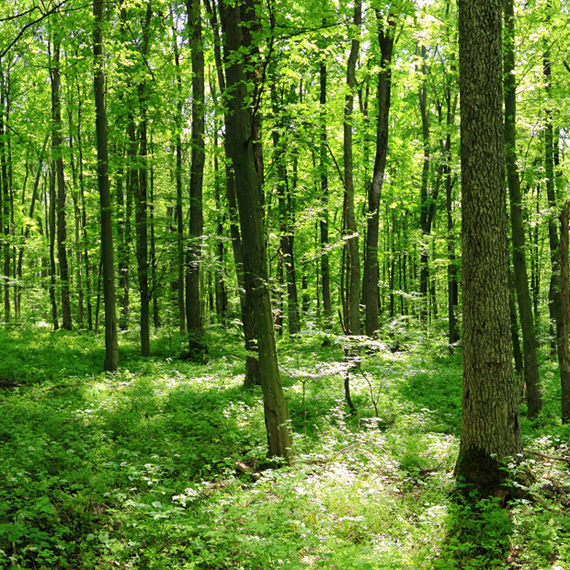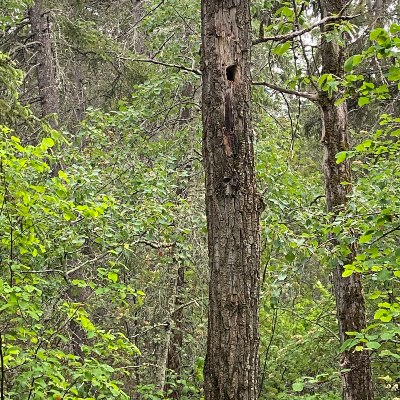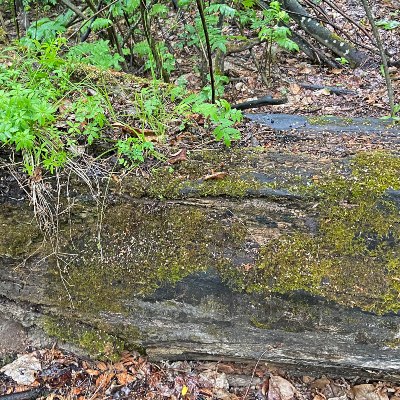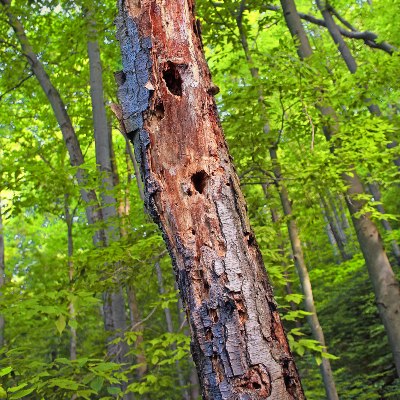How Changes in the Landbase Affect Individual Habitat Elements
In this section we evaluate how landbase changes (e.g. new forestry footprint, fire) over 2010-2018 in Norbord's operating areas are predicted to affect specific habitat elements, such as large deciduous trees.
Predicted net change in relative abundance as a result of changes in the landbase (2010-2018):
Large Deciduous Trees
North: -0.2% | South: -1.4%

Large Deciduous Snags
North: -0.2% | South: -1.7%

Large Fallen Logs
North: -0.2% | South: +4.0%

Introduction
In this section we provide summaries of the overall predicted change in specific habitat elements due to different types of change on the landbase, including changes as a result of forestry (new and old), non-forestry footprint (new and old), fire, and aging of undisturbed stands. Results are presented for habitat elements in mixedwood and deciduous forests that are difficult to manage for, including: deciduous trees > 25 cm DBH, snags > 25 cm DBH, and fallen logs > 25 cm DBH. Details for calculating attribution can be found in the Methods.
.jpg)
Deciduous snags provide habitat for a variety of species, such as cavity-nesting birds.
Results
Effects of Landbase Change on Individual Habitat Elements
We use “vector diagrams” to show the effects of each type of landbase change on five habitat elements in the Northern and Southern Operating areas: live deciduous tree basal area (m2/ha), live deciduous trees > 25 cm DBH, deciduous snags > 25 cm DBH, and fallen logs > 25 cm DBH. To interpret the vector diagrams, follow the arrows from the top of the figure, starting at 0% change, to the bottom to see the predicted effects on each habitat element as a result of:
- new forestry, then
- the additional effect of old regenerating harvest areas, then
- new non-forestry human footprint, then
- changes or disappearance of old non-forestry human footprint, then
- fires, and finally
- aging of undisturbed native forest.
The endpoint is the net change predicted in that element from 2010 to 2018.
Click on a habitat element to view the effects of landbase change

From soil to canopy, large deciduous trees add structure to boreal forests, providing habitat and foraging opportunities for a range of species. Further, large trees are eventually recruited to large snags or downed logs, serving as habitat for a host of other species. Large deciduous trees can be difficult to maintain in areas impacted by human disturbances.
Northern Operating Area
- New forestry was predicted to have reduced the abundance of large deciduous trees by 3.1% between 2010 and 2018.
- Regenerating older harvest areas added 0.8% of that back.
- Other human footprint is rarer in the area and had little effect.
- Fires reduced the predicted abundance a further 1.2%, while aging of undisturbed stands increased abundance by 3.4%.
- The net effect was almost no change in the abundance of large deciduous trees due to landbase changes from 2010 to 2018 in the Northern Operating Area.
Southern Operating Area
- In the Southern Operating Area, new forestry had a larger predicted effect on large deciduous trees than in the north, with a reduction of 5.8%.
- With a longer history of older forestry, there was a greater positive contribution from the regeneration of old harvest areas (+2.9%) than in the Northern Operating Area.
- More new non-forestry human footprint reduced the element in the Southern Operating Area a further -1.1%.
- Fires were largely absent in this area, and therefore had no effect on relative abundance.
- Aging of undisturbed stands increased the abundance by about 2.7%.
- The net predicted change in large deciduous trees was -1.4% in the Southern Operating Areas as a result of new forestry, which was mostly offset by the aging of harvested and naturally disturbed stands.

Snags (standing dead trees) greater than 25 cm in diameter are most abundant in mature/old deciduous and mixedwood forests. There are many cavity-nesting species, such as the Pileated Woodpecker, that prefer large diameter deciduous snags for nesting and foraging. This element can be difficult to maintain in areas impacted by human disturbance.
Northern Operating Area
- New forestry reduced the abundance of large deciduous snags by 1.4% between 2010 and 2018.
- Regenerating older harvest areas added 1.5% of large deciduous snags back.
- Other human footprint is rarer in the area and had little effect.
- Fires reduced the predicted abundance a further 0.5%, while aging of undisturbed stands increased abundance by 0.4%.
- The net effect was almost no change in the abundance of large deciduous snags due to landbase changes from 2010 to 2018 in the Northern Operating Area.
Southern Operating Area
- In the Southern Operating Area, new forestry had a larger predicted effect on large deciduous snags than in the north, with a reduction of 4.1%.
- With a longer history of older forestry, there was a greater positive contribution from the regeneration of old harvest areas (+3.6%) than in the Northern Operating Area.
- More new non-forestry human footprint reduced abundance in the Southern Operating Area a further 0.9%.
- Fires were largely absent in this area, and therefore had no effect on abundance.
- Aging of undisturbed stands resulted in almost no change (-0.2%).
- The net predicted change in large deciduous snags was -1.7% in the Southern Operating Areas with negative changes due to new forestry mostly offset by aging harvested stands.
Northern Operating Area
- New forestry was predicted to have reduced the abundance of large fallen logs by 2.1% between 2010 and 2018.
- Regenerating older harvest areas had little effect.
- Other human footprint is rarer in the area and had little effect.
- Fires reduced the predicted abundance a further 1.2%, while aging of undisturbed stands increased abundance by 3.0%.
- The net effect was almost no change in the abundance of large fallen logs due to landbase changes from 2010 to 2018 in the Northern Operating Area.
Southern Operating Area
- In the Southern Operating Area, new forestry had a small positive effect of +0.8% on large fallen logs.
- There was a negative effect of old forestry with a reduction of 1.0%.
- More new non-forestry human footprint reduced large fallen logs a further 0.8%.
- Fires were largely absent in this area, and therefore had no effect on abundance.
- Aging of undisturbed stands had the largest predicted effect on the abundance of large fallen trees of any landbase change, increasing abundance by 5.2%.
- The net predicted change in large fallen trees was +4.0 in the Southern Operating Areas, which is due almost entirely to aging of naturally disturbed stands.





